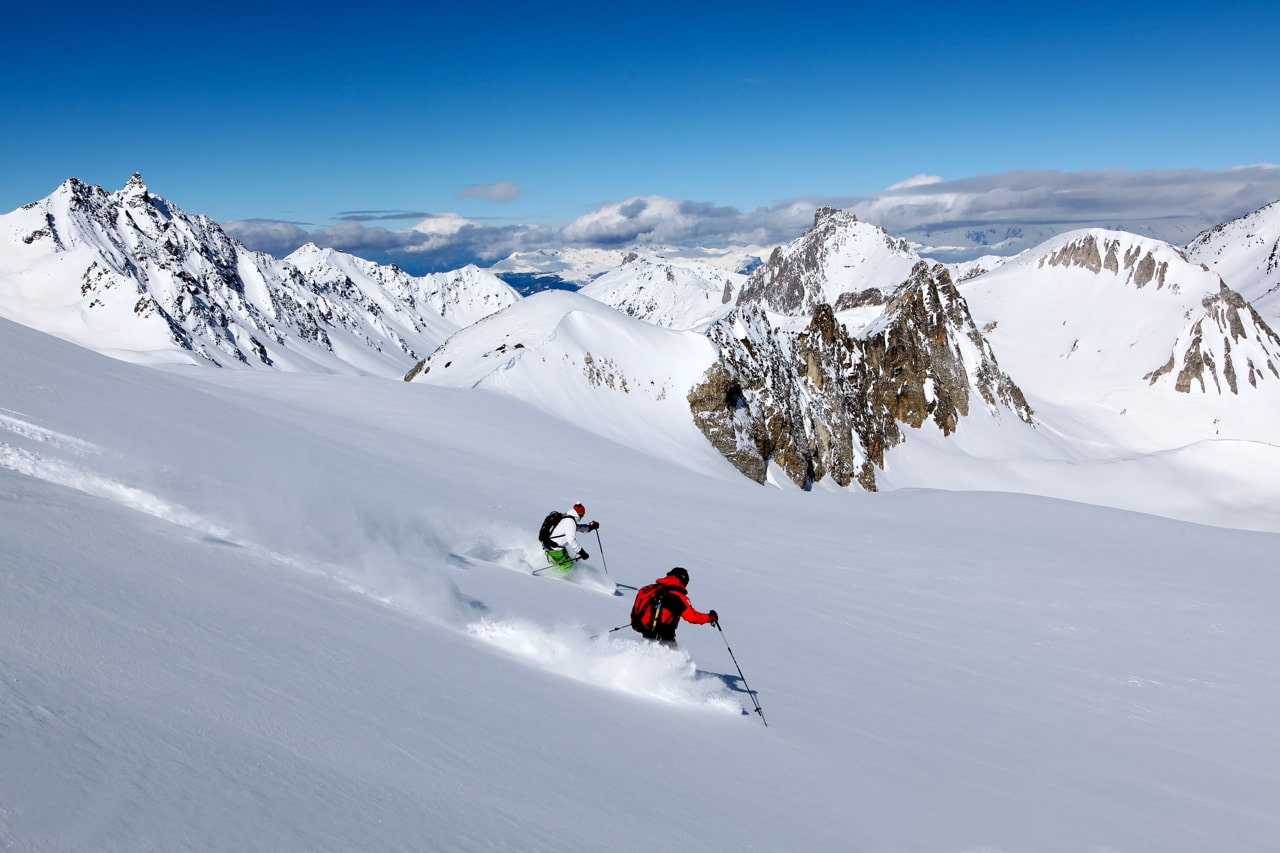
Off-piste snow skiing can be an exhilarating adrenalin activity. Like most high adrenalin activities however, it can also be dangerous if not practised safely.
In this blog we give our top tips for heading off piste and debunk a few myths.
Off piste - official advice
The basic official advice for off piste skiing is fairly simple:
- Only ski off-piste with a qualified guide
- Ensure you are equipped with the correct minimum safety equipment (a DVA Transceiver with fully charged batteries, a rucksack with a shovel and a probe)
- Check the weather and the avalanche risk level
Further considerations for skiing off piste
Amongst other things you need to pay attention to:
- Your technical abilities to ski any steep slopes that you may come across with no easier alternative
- Your technical abilities to ski ungroomed slopes (powder or other types of snow that you can find away from the groomed pistes like ‘cardboard’ snow)
- Your equipment - your type of skis obviously (in powder fat wider skis tend to perform better), but also your clothing
- Not only the weather conditions on the day but the weather conditions the preceding days (high wind, rapid changes in temperature, rain at high altitude, quantities of fresh snow that has fallen in the hours/day preceding can all increase the risk of avalanches in specific situations.
Most killer avalanches are caused by slabs slipping (layers of snow that just glide on other layers). They tend to happen on slopes steeper then 30-35 degrees with 38 degrees being a figure that sees the most but then they could well set-off on a steep slope and finish on a milder gradient slope where you have ended-up.
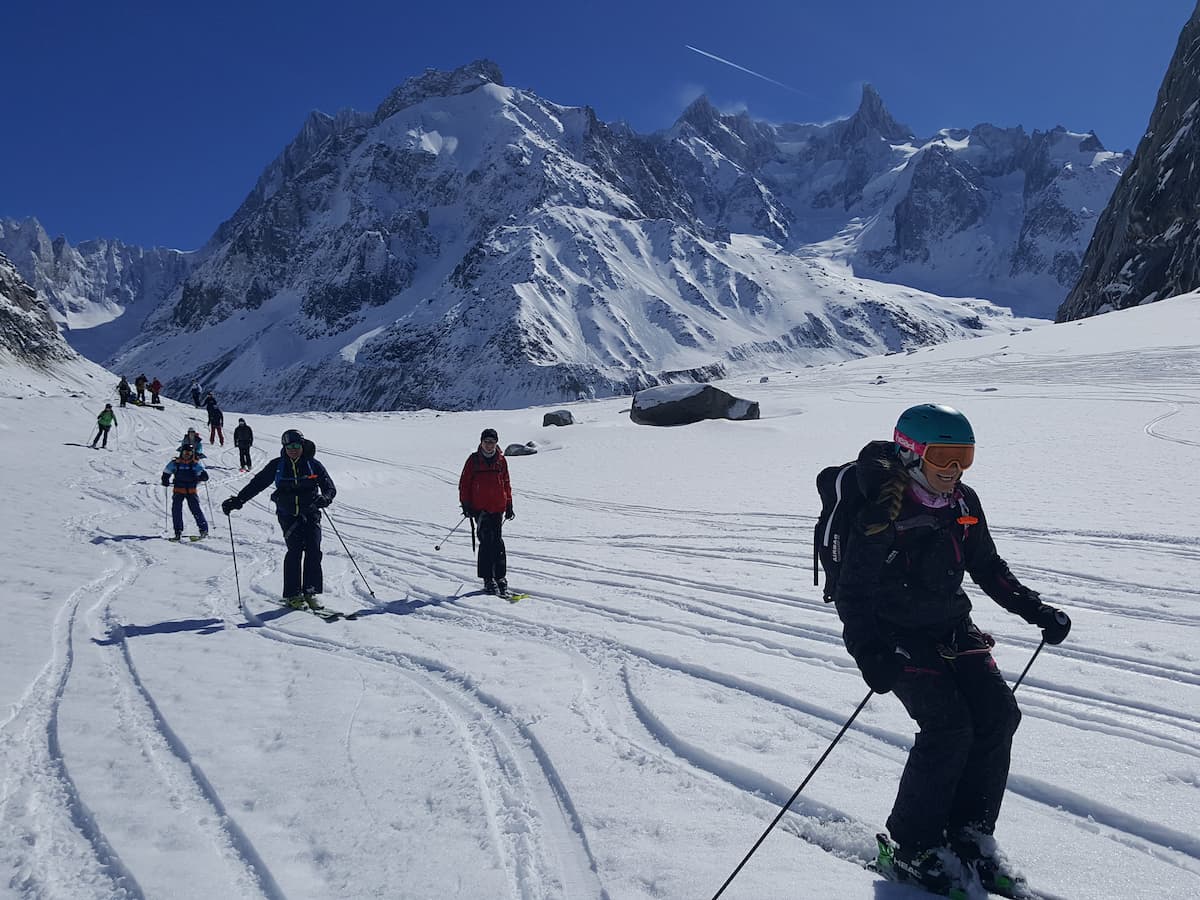
Peak Retreats team members at the end of the famous Vallée Blanche in Chamonix
Debunking the myths
There are invariably a lot of myths that circulate about off piste skiing so let's debunk some of the main ones...
MYTH: You need to be an expert skier to enjoy off-piste skiing adventures
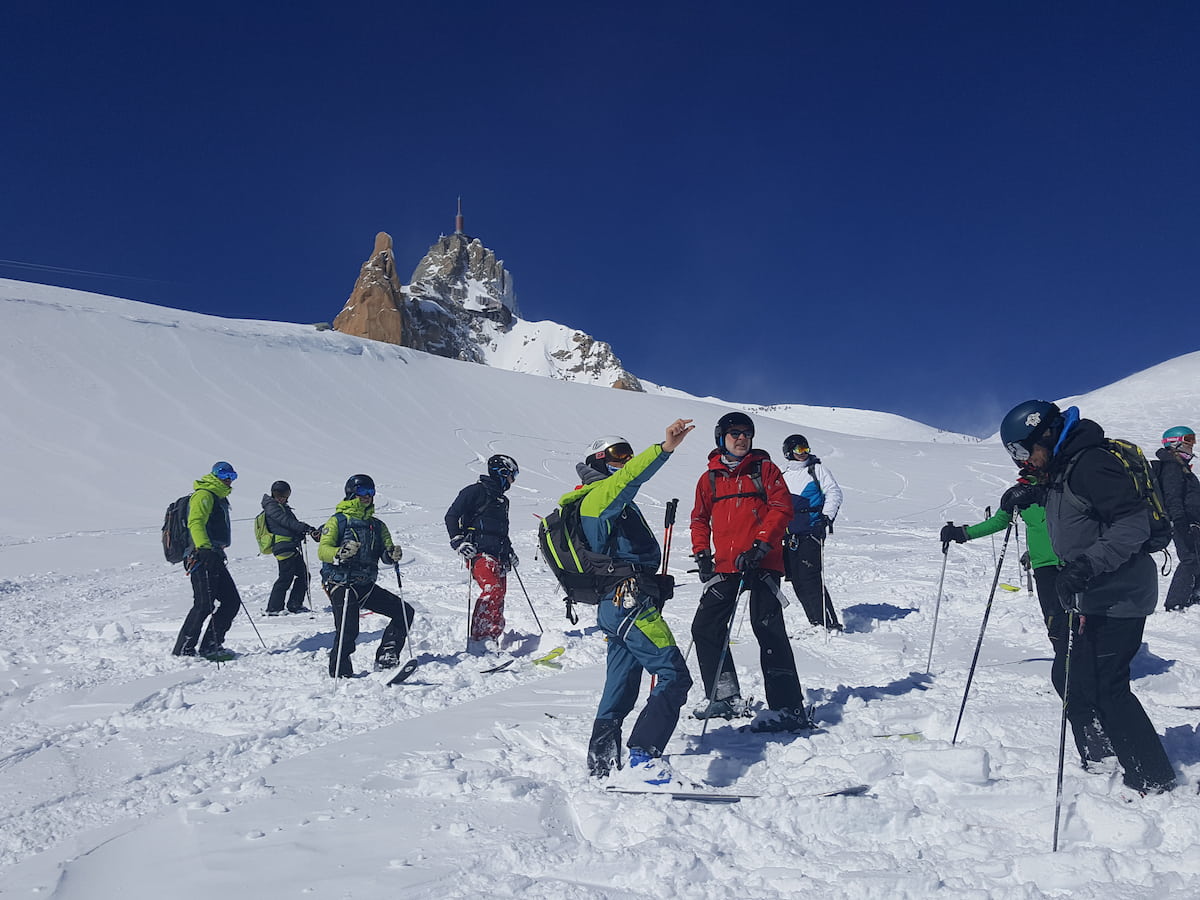
Peak Retreats team members below the Aiguille du Midi on the Vallée Blanche route in Chamonix
Reality: The Famous 20km long Vallee Blanche in Chamonix can be skied by high intermediates confident on red slopes if the conditions are right (snow quality, weather). A guide is essential though.
We have used the Compagnie des Guides de Chamonix ourselves but there are many qualified independent High Mountain guides (Guides de Haute Montagne).
Find accommodation in Chamonix
Resorts like Sainte Foy Tarentaise also offer excellent off-piste for good intermediate skiers.
One route that some of our team have done with an experienced guide is Le Monal.
The renowned run starts at the top of Sainte Foy at 2,620 meters and the Col de l'Aiguille where you enter a massive gentle bowl and some of the backcountry for which Sainte Foy is rightly famous.
The route then takes you down to the Vallon de Clou where you will experience a real feel of wilderness without feeling intimidated. From there you will continue all the way down to the inhabited (in winter) but protected village of Le Monal where you can enjoy the magnificent scenery (splendid views towards the glaciers in Val d’Isere, Tignes and Les Arcs’ Aiguille Rouge), memorable holiday photo opportunities and some regional produce before setting off again gently skiing back on a traverse towards the main ski area.
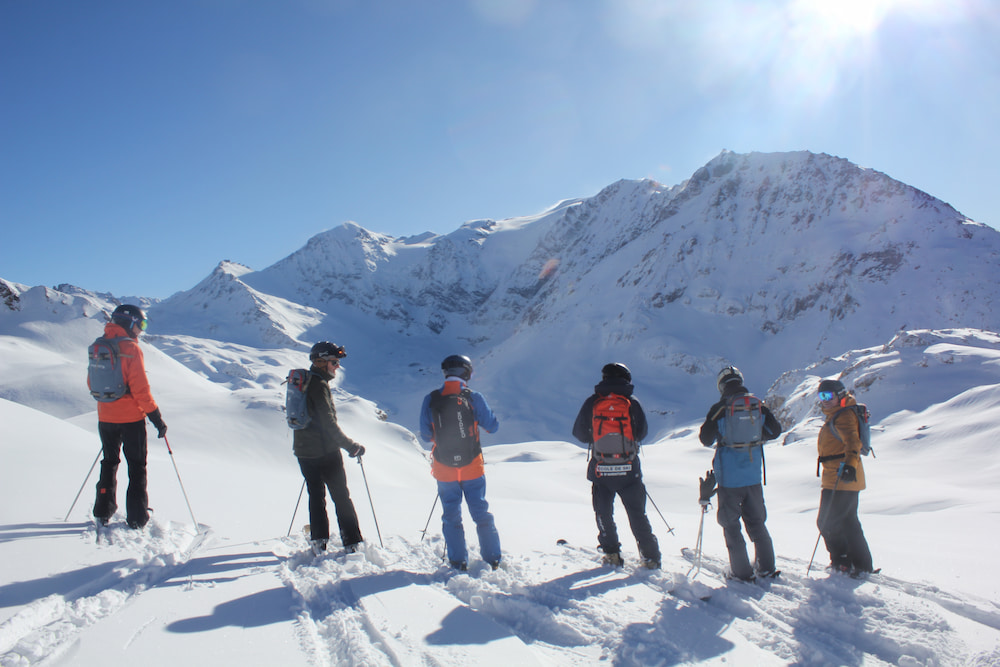
Peak Retreats team members starting Le Monal off-piste itinerary in Sainte Foy Tarentaise © Daniel Elkan / SnowCarbon
MYTH: Off-piste skiing along the slopes is okay without proper equipment or without a guide. Especially since many areas along the slopes will have low avalanche risk because steps will have been taken to secure the slopes nearby.
Reality: Whilst you may feel you don’t need a guide to practise your powder skills on the side of the slopes and whilst it is often true that some of these areas may be safer than remote areas away from the marked slopes (because the securing of the slopes by the resort piste safety team will have been carried out daily), there are at least three factors that you should consider:
- You could put the life of people on the slopes below where you are skiing at risk by triggering an avalanche that would not otherwise have happened.
- There could be hidden dangers. When Michael Schumacher had his tragic accident in 2013 in Meribel he knew the ski area very well, he was a very good skier and he was on a stretch technically off-piste less than 10 metre from a marked slope. He hit one of the several exposed rocks in the uncleared section of snow and lost control. He then lost balance and fell forward colliding with another rock 3.5 metres away, striking the right side of his head. His helmet was cracked in two by the impact.
- If you have an accident outside the marked slopes everything (the rescue amongst other things) could become more complicated and more expensive. In the case of Michael Schumacher the fact that his accident happened technically off-piste created a significant amount of complications in the aftermath.
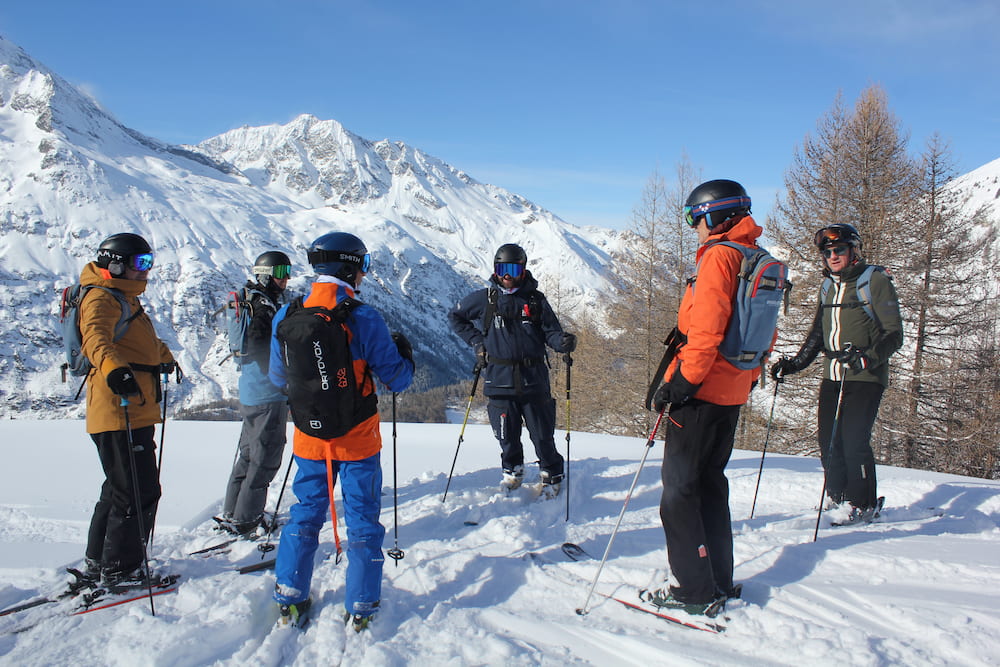
Peak Retreats team members with their ski guide in Sainte Foy Tarentaise © Daniel Elkan / SnowCarbon
MYTH: An avalanche risk of 3/5 is still okay
Reality: 3 out of a scale of 5 is actually high risk with about 2/3 of accidents every year at this risk level. From level 3 and above maximum vigilance is advised. Every resort in France displays the avalanche risk in various places.
You can also ask any of the ‘pisteurs’ the piste safety teams. Meteo France, the French official weather centre also displays the information on its website for the various areas.
MYTH: All I need is a DVA transceiver, no need for the backpack with the shovel and probe
Reality: Often what takes the longest, especially for untrained fellow skiers is not to locate the approximate location of the buried skier, it’s to dig them out. Without a probe to find the exact location within the range indicated by the DVA Transceiver there is an element of trial and error where you dig.
Digging hard packed snow without a shovel is mission impossible. The general consensus is that casualties have to be located within 15 mins of being buried to stand a good chance of survival.
You need to remember that you can easily be buried very deep. 15% of fatalities in France between 2012 and 2022 were buried under 2 metres of snow.
Once the snow settles after an avalanche it is often packed rock hard so clearing the snow around a casualty can require a huge amount of physical effort even with the right equipment.
Off piste skiing: ready, set, safe
France sees about 50 million skier visits every year and to keep things in proportion, there are about 25 fatalities (10 year average) every year in France in 100-120 recorded accidents. The vast majority of skiers do of course only ski on marked slopes, secured by the resort safety teams but still the number of fatal accidents due to avalanches remains fairly rare.
The danger of skiing off-piste is however not just avalanches, it’s hidden dangers like rocks, tree roots, unexpected cliffs, crevasses (the main reason why you should never undertake the Chamonix Vallee Blanche without a guide).
Skiing off-piste can be tremendous fun and thrill but it requires thoughts and preparation so we don’t recommend you just give it a go on the spur of the moment, when there is tempting fresh virgin powder.
Equally when slopes that you know, that you have done before are closed it can be tempting to ignore the signs and go past the nets. Don’t! Fatalities have tragically happened in late 2024 after closed signs were ignored.
Finally, if you want to try off-piste skiing why don’t you book into a tuition session. We can organise a qualified instructor for individuals or for a little group. They will teach you about the safety and the skills in a safe manner.
Depending on whether the area is classified as ‘glacier’ or not a ski instructor or ‘Guide de Haute Montagne’ will be competent to lead you. We don’t organise ‘Guide de Haute Montagne’ ourselves but we have used the local Compagnie des Guides for our own outings in various resorts.